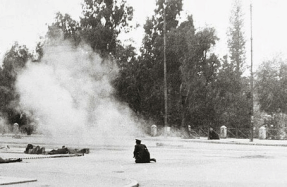NASHVILLE



On the fog-shrouded morning of 15 December 1864, the soldiers of the 14th US Colored Troops broke through the thin screen of Confederate skirmishers posted in the rifle pits, in front of the Chattanooga & Nashville Railroad. After regrouping, they surged across the railway tracks in a bid to outflank the right of the Confederate lines on the outskirts of Nashville.
Suddenly, Confederate 12-pounder smoothbore guns in a lunette adjacent to the tracks erupted with canister – tin cans filled with deadly iron balls – which shredded the regiment’s ranks. Confederate infantry, which had been hiding in a stand of timber, fired a thunderous volley into the Union regiment’s ranks. The survivors fled in the direction from which they had come – within ten minutes they had lost 117 men.
It was the kind of tactical success that Confederate General John Bell Hood so desperately sought when he lured Union Major General George Thomas to attack his earthworks on the south side of Nashville after a nearly two-week standoff between the armies.
In the war-ravaged South in the final months of the conflict, Hood lacked the troops that would be needed to capture Nashville. Because of this, the best he could hope for was to inflict heavy casualties on Thomas’ army, which had been cobbled together from various Union commands in the Western Theatre to take on the crack troops of Hood’s Army of Tennessee. If the Confederates could continue throughout the day to repulse other piecemeal Union attacks with similar success, Hood just might win a tactical victory against a much larger Union army.
“WHILE HOOD’S FIGHTING SPIRIT WAS UNDIMINISHED, HIS BODY HAD BEEN RAVAGED BY INJURIES SUFFERED IN BATTLE”
Long odds for success
The battered armies of the Confederate States of America faced near-certain defeat by
You’re reading a preview, subscribe to read more.
Start your free 30 days





